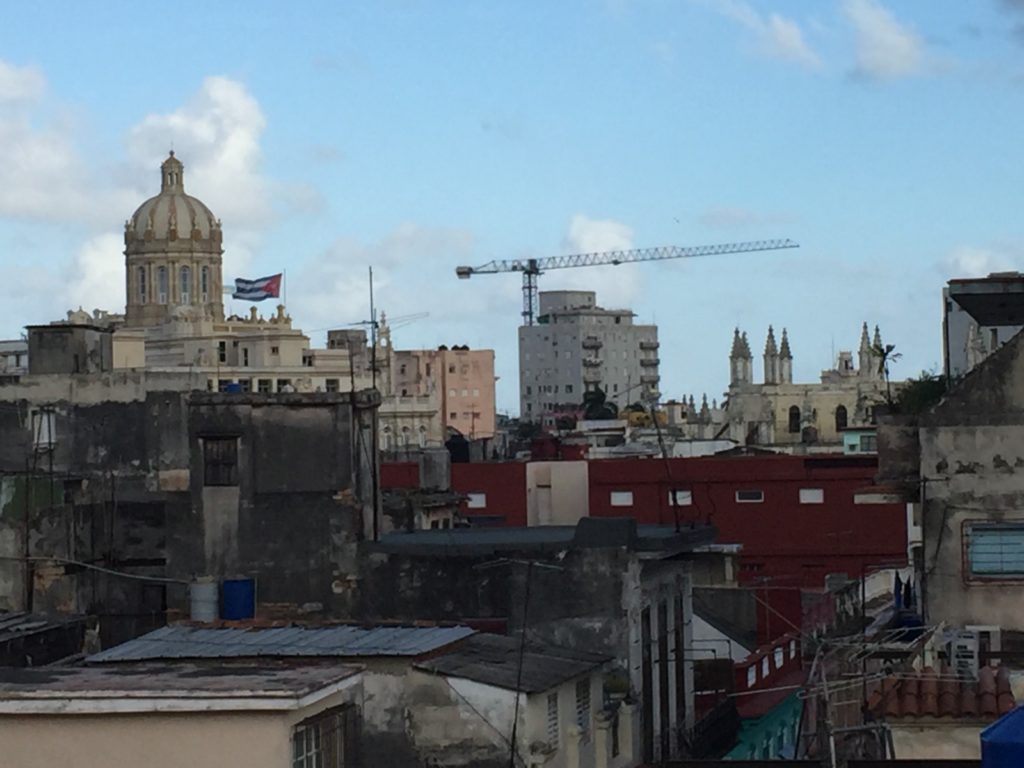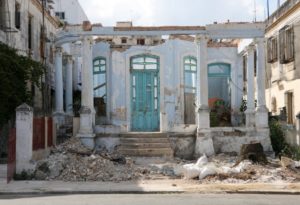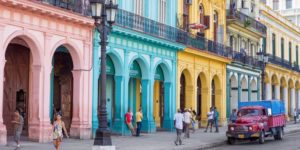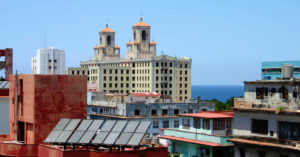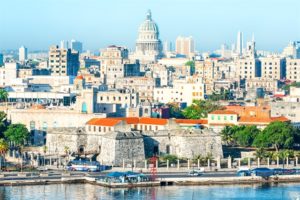 FRENESÍ DE INVERSIONES Y APUESTAS POR CAPITAL EXTRANJERO SACUDEN A LA HABANA.
FRENESÍ DE INVERSIONES Y APUESTAS POR CAPITAL EXTRANJERO SACUDEN A LA HABANA.
A juzgar por la información publicada en la más reciente Cartera de Oportunidades de Inversión Extranjera, elaborada por el Ministerio de Comercio Exterior de Cuba, así como la inserción del área donde está emplazado el histórico edificio entre los proyectos de la Oficina del Historiador para celebrar los 500 años de la capital, muy pronto, frente al recién restaurado Capitolio, veremos alzarse al menos un imponente cinco estrellas de trescientas habitaciones.
Preconcebido por Gaviota S.A., perteneciente al Grupo Empresarial de las Fuerzas Armadas Revolucionarias (FAR), el nuevo complejo de edificaciones para el turismo abarcaría totalmente la manzana comprendida entre las calles San José, Teniente Rey, Zulueta y Paseo del Prado y estaría integrado por un segundo hotel de categoría y capacidad similares a las del futuro Payret, así como una galería comercial donde hoy existe la Sala Deportiva Kid Chocolate.
De acuerdo con informaciones ofrecidas a CubaNet, tanto por funcionarios de la Unidad de Construcciones Militares (UCM) como de la propia Gaviota S.A., el proyecto ha sido insertado en los planes de inversiones a corto y mediano plazos que buscarían transformar los alrededores del Capitolio, donde ya tiene su sede oficial la Asamblea Nacional, en una especie de gran vitrina de exhibición que se extendería desde los hoteles Isla de Cuba, situado en la calle Monte y actualmente en ruinas aunque próximo a ser restaurado, atravesando el Paseo del Prado y llegando a Malecón, donde ya funciona el segundo cinco estrellas plus de Cuba y donde además habrá de inaugurarse, en pocos meses, el hotel Prado y Malecón, al que la cadena francesa Accor considera su principal joya en la isla caribeña.
“Se están valorando varias propuestas (…). Una de ellas sería conservar todas las fachadas del Payret y parte del interior, parte de la decoración (…), es la propuesta que posiblemente sea la definitiva aunque tiene algunos detractores por el significado histórico y cultural del Payret como teatro (…), hay otras propuestas (…) una sala de reuniones para la Asamblea Nacional (…) aunque creo finalmente se impondrá el hotel, junto a otro (el Hotel Pasaje) que supondría la reubicación de unas cien familias que todavía viven en la cuadra, así como otro centenar en las cercanías al Capitolio”, señala un funcionario de Gaviota bajo condición de anonimato.
Su declaración coincide en buena medida no solo con lo inscrito por la Oficina del Historiador en las señalizaciones del solar que hace esquina en Teniente Rey y Paseo de Martí (Prado) sino con la de funcionarios de la UCM, la empresa cubana encargada de la ejecución de los trabajos junto a la francesa Bouygues Bâtiment International.
La inversión total superaría los 300 millones de dólares, una cifra difícil de conseguir sin un socio extranjero, por tanto la parcela se encuentra actualmente entre un total de doce adjudicadas a Gaviota en la capital y que han sido priorizadas en la nueva Cartera de Oportunidades.
“Toda esa zona está pidiendo a gritos una restauración de las estructuras así como un cambio de sus funciones actuales, más por su integración a un conjunto donde está el Capitolio, el Gran Teatro, los hoteles del entorno, entre ellos el Manzana (…), hay dos edificios en peligro de derrumbe, uno de ellos es el que está frente al Tribunal Provincial (…), por las condiciones en que se encuentra tendrá que ser demolido, mientras de los que están frente al Capitolio se aprovechará parte de las fachadas (…), la sala Kid Chocolate tendría que ser trasladada y en su lugar se levantaría el Hotel Pasaje y una galería comercial similar a la que existía antes de ser transformado el lugar en complejo deportivo”, asegura la misma fuente.
Sólo en el perímetro, conocido en los documentos de la entidad empresarial como “Manzana Payret”, Gaviota pretende incorporar unas 600 habitaciones a un plan que busca incrementar las capacidades de La Habana a unas 6 mil, en menos de cinco años, y que afianzaría a la corporación militar como líder en el sector hotelero cubano al superar, con la sumatoria del total de inversiones, en casi un 40 por ciento las 28 163 habitaciones con que cuenta actualmente en todo el país, una cantidad a la que apenas logra acercarse Cubanacán S.A. con 15 585, a pesar de contar con más años de operaciones que Gaviota, fundada a inicios de los 90, en plena crisis económica del llamado “Período Especial”.
“No existe otra entidad que tenga tantos proyectos en ejecución al mismo tiempo”, afirma a CubaNet un funcionario de la UCM: “Se trabaja en la construcción de una decena de hoteles nuevos en la capital, y se estudia el desarrollo de unos veinte más en las diferentes parcelas que se han priorizado en La Habana (…). Para el próximo año se espera comenzar dos proyectos en las parcelas cercanas al Acuario Nacional, entregar el P1D, ya avanzado, en lo que antes era la Feria de Malecón, varios hoteles en la calle 23, entre ellos otro cinco estrellas plus, frente a Coppelia, que sería el más alto de Cuba, además de la restauración de otros hoteles en el mismo Casco Histórico, la rehabilitación de la manzana del Payret con dos hoteles, así como el Isla de Cuba al inicio del Paseo del Prado”, asegura esta otra fuente consultada al respecto.
A la espera de la luz verde para el comienzo de las obras, el Payret permanece cerrado y sin que ninguna de las pocas personas que aún laboran allí, fundamentalmente como guardias de seguridad, sepa cuál será el destino de uno de los edificios más emblemáticos del entorno habanero. “Un día dicen que seguirá siendo un cine, otros que pasará al Parlamento (Asamblea), pero ahora están diciendo que harán un hotel y que entonces nosotros iremos para el Campoamor (antiguo Teatro Capitolio) cuando lo terminen pero eso allí no avanza mucho, yo creo que terminarán demoliéndolo. Hace falta que decidan qué van a hacer”, opina un trabajador de la instalación entrevistado al respecto.
El rediseño de la “manzana Payret” marcharía aparejado a otras labores constructivas y de restauración en los alrededores del Capitolio, un torrente inversionista que incluiría las rehabilitaciones del Teatro Campoamor, edificios multifamiliares y de oficinas al fondo del Gran Teatro, así como la transformación o demolición de muchas de las cuarterías que abarca el tramo de la calle Industria, al fondo del Capitolio, algunas de las cuales hoy se encuentran abandonadas debido a los derrumbes o la falta de condiciones para continuar siendo habitadas.
Un extraordinario frenesí de inversiones y apuestas por el capital foráneo que contrasta enormemente con el aumento de los problemas de la vivienda en la isla, la lentitud en la búsqueda de soluciones inmediatas y duraderas para las personas que han perdido sus hogares o están en vías de perderlos por causa del deterioro de los inmuebles o del periódico impacto negativo de fenómenos meteorológicos, la perpetuidad del desabastecimiento de materiales para la construcción o reparación del fondo habitacional de la población, así como el escaso empeño del gobierno en mejorar la imagen y las condiciones de una ciudad que debiera ser proyectada y acondicionada de acuerdo con las necesidades y anhelos de quienes la viven en perpetuidad y no en exclusiva para aquellos que la visitan brevemente.
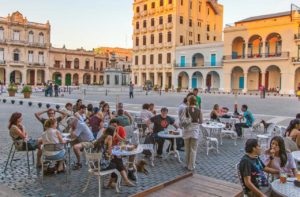 FRENESI OF INVESTMENTS AND BETS FOR FOREIGN CAPITAL SHAKE TO HAVANA.
FRENESI OF INVESTMENTS AND BETS FOR FOREIGN CAPITAL SHAKE TO HAVANA.
Judging by the information published in the most recent Portfolio of Opportunities for Foreign Investment, prepared by the Ministry of Foreign Trade of Cuba, as well as the insertion of the area where the historic building is located among the projects of the Office of the Historian to celebrate the 500 years from the capital, very soon, in front of the recently restored Capitol, we will see at least an imposing five stars of three hundred rooms.
Preconceived by Gaviota SA, belonging to the Business Group of the Revolutionary Armed Forces (FAR), the new complex of buildings for tourism would cover the entire block between San José, Teniente Rey, Zulueta and Paseo del Prado streets and would be integrated by a second hotel of category and capacity similar to those of the future Payret, as well as a commercial gallery where today the Kid Chocolate Sports Hall exists.
According to information offered to CubaNet, both by officials of the Military Building Unit (UCM) and Gaviota SA itself, the project has been inserted into short and medium term investment plans that seek to transform the surroundings of the Capitol, where the National Assembly already has its official headquarters, in a kind of large showcase that would extend from the Isla de Cuba hotels, located on Monte Street and currently in ruins, but soon to be restored, crossing the Paseo del Prado and arriving to Malecón, where the second five plus stars of Cuba already operate and where the Prado and Malecón hotel, which the French chain Accor considers its main jewel on the Caribbean island, will be inaugurated in a few months.
“Several proposals are being evaluated (…). One of them would be to conserve all the facades of the Payret and part of the interior, part of the decoration (…), it is the proposal that is possibly the definitive one although it has some detractors for the historical and cultural significance of Payret as theater (…), there is other proposals (…) a meeting room for the National Assembly (…) although I believe the hotel will eventually be imposed, along with another (the Hotel Passage) that would involve the relocation of about a hundred families still living in the block, as well as another hundred near the Capitol, “says a Gaviota official on condition of anonymity.
His statement largely coincides not only with what is inscribed by the Office of the Historian in the signage of the lot that is on the corner of Teniente Rey and Paseo de Martí (Prado), but also that of officials of the UCM, the Cuban company in charge of the execution of the works with the French Bouygues Bâtiment International.
The total investment would exceed 300 million dollars, a figure difficult to achieve without a foreign partner, therefore the plot is currently among a total of twelve awarded to Gaviota in the capital and have been prioritized in the new Portfolio of Opportunities.
“All that area is crying out for a restoration of the structures as well as a change of its current functions, more for its integration to a set where the Capitol, the Grand Theater, the surrounding hotels, including the Apple (…) , there are two buildings in danger of collapse, one of them is the one in front of the Provincial Court (…), because of the conditions in which it is located, it will have to be demolished, while those in front of the Capitol will take advantage of part of the facades (…), the Kid Chocolate room would have to be moved and in its place would be the Hotel Passage and a commercial gallery similar to the one that existed before being transformed the place in sports complex “, assures the same source.
Only in the perimeter, known in the documents of the business entity as “Apple Payret”, Gaviota intends to incorporate some 600 rooms to a plan that seeks to increase the capacities of Havana to about 6 thousand, in less than five years, and that would strengthen to the military corporation as a leader in the Cuban hotel sector to overcome, with the sum total of investments, by almost 40 percent the 28 163 rooms that currently account throughout the country, an amount that can barely approach Cubanacán SA with 15 585, despite having more years of operations than Gaviota, founded at the beginning of the 90s, in the middle of the economic crisis of the so-called “Special Period”.
“There is no other entity that has so many projects running at the same time,” an official from the UCM told CubaNet: “We are working on the construction of a dozen new hotels in the capital, and we are studying the development of about twenty more in the different plots that have been prioritized in Havana (…). For the next year it is expected to start two projects in the parcels near the National Aquarium, to deliver the P1D, already advanced, in what was previously the Malecón Fair, several hotels on 23rd Street, including another five stars plus, in front of Coppelia, which would be the highest in Cuba, in addition to the restoration of other hotels in the same Historic Area, the rehabilitation of the Payret block with two hotels, as well as the Island of Cuba at the beginning of the Paseo del Prado “, says another source consulted about it.
While waiting for the green light to start work, the Payret remains closed and none of the few people still working there, mainly as security guards, know what the fate of one of the most emblematic buildings in the city will be. Havana environment. “One day they say it will continue to be a cinema, others will go to the Parliament (Assembly), but now they are saying that they will make a hotel and then we will go to the Campoamor (old Capitolio Theater) when they finish it but that does not progress much, I believe that they will end up demolishing it. They need to decide what they are going to do “, says a worker from the facility interviewed about it.
The redesign of the “Payret apple” would go hand in hand with other construction and restoration work in the vicinity of the Capitol, an investor torrent that would include the rehabilitations of the Campoamor Theater, multifamily and office buildings at the back of the Grand Theater, as well as the transformation or demolition of many of the cuarterías that covers the section of Industria Street, at the bottom of the Capitol, some of which today are abandoned due to landslides or the lack of conditions to continue being inhabited.
An extraordinary frenzy of investment and bets for foreign capital that contrasts sharply with the increase in housing problems on the island, the slowness in the search for immediate and lasting solutions for people who have lost their homes or are in the process of to lose them due to the deterioration of the buildings or of the newspaper, negative impact of meteorological phenomena, the perpetuity of the shortage of materials for the construction or repair of the housing stock of the population, as well as the scarce commitment of the government to improve the image and conditions of a city that should be projected and conditioned according to the needs and desires of those who live it in perpetuity and not exclusively for those who visit it briefly.
Agencies/ Cubanet/ Internet Photos/ Arnoldo Varona/ www.thecubanhistory.com
THE CUBAN HISTORY, HOLLYWOOD.




